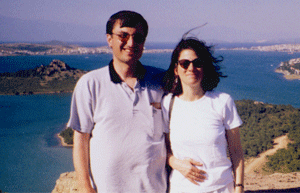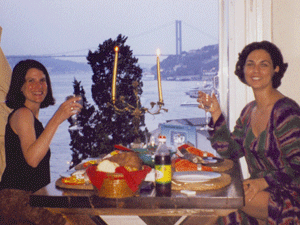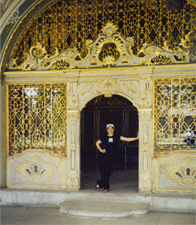Worlds Apart, Together in Turkey
By Valerie Block*
I’d been dating Musa for several months when he told me he was going back home to Turkey. I figured it was goodbye boyfriend, but he surprised me by phoning often. Two months into his absence, I was on a plane to Istanbul!
I’d been dating Musa for several months when he told me he was going back home to Turkey. I figured it was goodbye boyfriend, but he surprised me by phoning often. Two months into his absence, I was on a plane to Istanbul!
Okay, we had our differences: Musa was a devout Muslim who’d come to New York to study English. I, a liberal Jewish New Yorker, worked full-time and was eight years older. Our relationship was doomed from the start.

But he made me laugh. So, this thirty-something journalist decided to go for an adventure that summer of 1998. After all, I’d never been further from Manhattan than Western Europe. A trip to Turkey promised to be exotic and romantic.
When I arrived at the airport, my handsome Turk was waiting to whisk me to the Istanbul, a patchwork of narrow cobblestone streets and crowded bazaars. He’d booked a hotel room near the famous Blue Mosque with its minarets piercing the sky.
He didn’t take me to the home he shared with his mother, who expected Musa to woo, if not a cousin, at the very least, a Muslim. I tried to overlook such little details as we went sightseeing in the ancient city that straddles Europe and Asia with the dazzling blue Bosphorus dividing it.
Exhausted from jet lag, I fell asleep easily that night. The following morning, at 5:30 a.m., I was jolted out of my slumber by Middle Eastern music. I wondered if a street party had started below our window. Musa laughed at my ignorance. This was the Muslim call to prayer, which I would hear five times a day. By my trip’s end, I slept right through the Mullahs.
On my first full day in Istanbul, we visited the sites of the Sultanhamet, or old city, including the Topkapi Palace, where the sultans once lived with their many wives. We walked through rooms filled with jewel-encrusted swords, imperial garments and other artifacts of the Ottoman Empire.
Outside, the city streets were crammed with people. Women wore long coats and head scarves despite the June heat. But they often walked arm in arm with girls wearing miniskirts and halter tops. The contrast between them seemed like a mirror to my relationship with Musa.
AYVALIK
Our plan was to hit the road early the next morning for a seaside vacation. Musa chose Ayvalik, a resort area more familiar to locals than tourists. The small fishing port on the Aegean Sea lies just south of the fabled city of Troy. To get there, we took advantage of the country’s fantastic bus system, which was cheap, convenient and comfortable.

Ayvalik, with its whitewashed architecture and miles of olive groves, still resembles the Greek town it was until the Greeks were expelled after the war of 1922. We stayed at a beachfront bungalow where the beach was quiet, the water cold and a deep blue. We ate dinner at a café on the bay in town, where we chose our fish whole and had it grilled.
The following day, Musa brought breakfast to the room, a traditional spread of olives, cheese, honey, cucumber, bread and strong Turkish tea. We spent the morning relaxing and then explored the area, hiking up to Seytan Sofrasi, or the Devil’s table, a plateau that offered dramatic views of the area’s many coves and inlets, as well as the Greek isle of Lesbos. We dined that evening at our bungalow colony’s outdoor restaurant and were serenaded by a local folk music act.
I was charmed by Ayvalik’s friendly residents, and relished my status as one of the few foreigners around.
VIRGIN MARY HOUSE
From Ayvalik, we headed south along the coast, stopping at Bergama, one of Turkey’s many Greek ruins that boasted a small coliseum and sparse crowds. But a more impressive display of ancient civilization awaited us at Ephesus, our next destination.
The relics in Ephesus are said to rival some of Greece’s most famous monuments. The city did not disappoint. The cobbled-stoned main street of the once-prosperous city was lined with stately homes and shops, with mosaics still visible on some walls. At the library, a two-story facade, statues of white marble stood out against the blue sky. Nearby, an ancient bathroom made for a fun photo opp.
After scouring the ruins, we headed down the road to the Virgin Mary house, where the mother of Christ is said to have spent her last days. As the sun set, we hailed a van to the resort town of Kusadasi, a crescent of white sand surrounded by mid-sized hotels, restaurants and shops, where we spent the night.
Musa never introduced me to his mother, but I did meet other relatives during the trip, like his cousin Ali Riza, who lived in a tiny village near Kusadasi. The old man was thrilled to see Musa, and didn’t ask questions about our relationship. He spoke no English, but Musa translated. In the town…well, hamlet, we picked up fresh lamb and vegetables to grill in Ali’s yard. And when I say fresh lamb, I mean, freshly killed and hanging in a dusty store window.
Along the road, women in colorful head scarves worked in green fields, and men rode donkeys laden with produce.
We never ventured further south to the Mediterranean, which remains a disappointment, but the more popular resort towns like Bodrum came with reputations of revelry that offended Musa’s religious sensibilities. He reminded me often that he didn’t “drink, smoke or play cards.” While he was no saint, he didn’t care to be among so many sinners.

YALOVA: THE SITE OF AN OTTOMAN ERA SPA
So, we agreed to turn back towards Istanbul and stop at Yalova, the site of an Ottoman era spa that had been a favorite of Kemal Ataturk, the founder of modern Turkey. I had heard about Turkish spas and was eager to spend time at one.
The hot spring resort is now popular with Arab families and many women strolled the grounds in black hijab, with just their eyes peering out. The women’s indoor bath, however, was jammed with naked bodies, children and laughter. I found it fascinating to see these shrouded women come to life.
I also enjoyed a relaxing massage for just a few dollars. Before leaving the small city, we dropped in on Musa’s first cousins Fatma and Mehmet and their toddler son. A traditional girl, Fatma was warm and welcoming and prepared a delicious lunch. In Turkey, it’s tradition to give guests a parting gift, so as we were leaving, Fatma handed me a pair of woolen socks she’d knitted herself. I snapped her photo in the doorway as she tried to adjust her headscarf, which had slipped to reveal some wisps of her hair.
Two hours on a high speed ferry and we were back in Istanbul. This time around, we stayed with Banu, a friend of a friend from New York. I’d never met Banu, but we hit it off immediately. While Musa was a religious conservative, Banu greeted us at her two-bedroom apartment in the fashionable Bebek neighborhood with a cigarette in one hand and a glass of wine in the other. We could have been sisters.
She arranged a small dinner and afterwards we went to listen to jazz at a crowded outdoor café. In the morning, Banu took me to a private club floating in the middle of the Bosphorus where we swam in a giant pool and ordered cocktails. With Musa, I went to the main Bazaar in the old city, where he bargained and I bought – rugs, jewelry, clothing.
For our last night, Musa picked Sehzade, a charming restaurant in a park near the city’s university. We sat under a tented canopy and ate köfte, or Turkish meatballs, while a band played traditional music.
At the airport Musa promised to return to New York soon. He kept his promise, but after three years of battling our differences, Musa moved back to Turkey for good and I moved on.
I’m married now, to a fellow Jewish New Yorker, but to my surprise, Musa still keeps in touch. I remain friends with Banu as well. Of all the things I brought back from Turkey from that trip, these are the souvenirs that mean the most to me.
* Valerie Block is Deputy Managing Editor of Crain's New York Business.
(February 2008, Tourism Special Issue)

Musa and Valerie atop Seytan Sofrasi in Ayvalik.
But he made me laugh. So, this thirty-something journalist decided to go for an adventure that summer of 1998. After all, I’d never been further from Manhattan than Western Europe. A trip to Turkey promised to be exotic and romantic.
When I arrived at the airport, my handsome Turk was waiting to whisk me to the Istanbul, a patchwork of narrow cobblestone streets and crowded bazaars. He’d booked a hotel room near the famous Blue Mosque with its minarets piercing the sky.
He didn’t take me to the home he shared with his mother, who expected Musa to woo, if not a cousin, at the very least, a Muslim. I tried to overlook such little details as we went sightseeing in the ancient city that straddles Europe and Asia with the dazzling blue Bosphorus dividing it.
Exhausted from jet lag, I fell asleep easily that night. The following morning, at 5:30 a.m., I was jolted out of my slumber by Middle Eastern music. I wondered if a street party had started below our window. Musa laughed at my ignorance. This was the Muslim call to prayer, which I would hear five times a day. By my trip’s end, I slept right through the Mullahs.
On my first full day in Istanbul, we visited the sites of the Sultanhamet, or old city, including the Topkapi Palace, where the sultans once lived with their many wives. We walked through rooms filled with jewel-encrusted swords, imperial garments and other artifacts of the Ottoman Empire.
Outside, the city streets were crammed with people. Women wore long coats and head scarves despite the June heat. But they often walked arm in arm with girls wearing miniskirts and halter tops. The contrast between them seemed like a mirror to my relationship with Musa.
AYVALIK
Our plan was to hit the road early the next morning for a seaside vacation. Musa chose Ayvalik, a resort area more familiar to locals than tourists. The small fishing port on the Aegean Sea lies just south of the fabled city of Troy. To get there, we took advantage of the country’s fantastic bus system, which was cheap, convenient and comfortable.

Valerie and Banu in her Bebek apartment.
Ayvalik, with its whitewashed architecture and miles of olive groves, still resembles the Greek town it was until the Greeks were expelled after the war of 1922. We stayed at a beachfront bungalow where the beach was quiet, the water cold and a deep blue. We ate dinner at a café on the bay in town, where we chose our fish whole and had it grilled.
The following day, Musa brought breakfast to the room, a traditional spread of olives, cheese, honey, cucumber, bread and strong Turkish tea. We spent the morning relaxing and then explored the area, hiking up to Seytan Sofrasi, or the Devil’s table, a plateau that offered dramatic views of the area’s many coves and inlets, as well as the Greek isle of Lesbos. We dined that evening at our bungalow colony’s outdoor restaurant and were serenaded by a local folk music act.
I was charmed by Ayvalik’s friendly residents, and relished my status as one of the few foreigners around.
VIRGIN MARY HOUSE
From Ayvalik, we headed south along the coast, stopping at Bergama, one of Turkey’s many Greek ruins that boasted a small coliseum and sparse crowds. But a more impressive display of ancient civilization awaited us at Ephesus, our next destination.
The relics in Ephesus are said to rival some of Greece’s most famous monuments. The city did not disappoint. The cobbled-stoned main street of the once-prosperous city was lined with stately homes and shops, with mosaics still visible on some walls. At the library, a two-story facade, statues of white marble stood out against the blue sky. Nearby, an ancient bathroom made for a fun photo opp.
After scouring the ruins, we headed down the road to the Virgin Mary house, where the mother of Christ is said to have spent her last days. As the sun set, we hailed a van to the resort town of Kusadasi, a crescent of white sand surrounded by mid-sized hotels, restaurants and shops, where we spent the night.
Musa never introduced me to his mother, but I did meet other relatives during the trip, like his cousin Ali Riza, who lived in a tiny village near Kusadasi. The old man was thrilled to see Musa, and didn’t ask questions about our relationship. He spoke no English, but Musa translated. In the town…well, hamlet, we picked up fresh lamb and vegetables to grill in Ali’s yard. And when I say fresh lamb, I mean, freshly killed and hanging in a dusty store window.
Along the road, women in colorful head scarves worked in green fields, and men rode donkeys laden with produce.
We never ventured further south to the Mediterranean, which remains a disappointment, but the more popular resort towns like Bodrum came with reputations of revelry that offended Musa’s religious sensibilities. He reminded me often that he didn’t “drink, smoke or play cards.” While he was no saint, he didn’t care to be among so many sinners.

Valerie at the Topkapi Palace in Istanbul.
YALOVA: THE SITE OF AN OTTOMAN ERA SPA
So, we agreed to turn back towards Istanbul and stop at Yalova, the site of an Ottoman era spa that had been a favorite of Kemal Ataturk, the founder of modern Turkey. I had heard about Turkish spas and was eager to spend time at one.
The hot spring resort is now popular with Arab families and many women strolled the grounds in black hijab, with just their eyes peering out. The women’s indoor bath, however, was jammed with naked bodies, children and laughter. I found it fascinating to see these shrouded women come to life.
I also enjoyed a relaxing massage for just a few dollars. Before leaving the small city, we dropped in on Musa’s first cousins Fatma and Mehmet and their toddler son. A traditional girl, Fatma was warm and welcoming and prepared a delicious lunch. In Turkey, it’s tradition to give guests a parting gift, so as we were leaving, Fatma handed me a pair of woolen socks she’d knitted herself. I snapped her photo in the doorway as she tried to adjust her headscarf, which had slipped to reveal some wisps of her hair.
Two hours on a high speed ferry and we were back in Istanbul. This time around, we stayed with Banu, a friend of a friend from New York. I’d never met Banu, but we hit it off immediately. While Musa was a religious conservative, Banu greeted us at her two-bedroom apartment in the fashionable Bebek neighborhood with a cigarette in one hand and a glass of wine in the other. We could have been sisters.
She arranged a small dinner and afterwards we went to listen to jazz at a crowded outdoor café. In the morning, Banu took me to a private club floating in the middle of the Bosphorus where we swam in a giant pool and ordered cocktails. With Musa, I went to the main Bazaar in the old city, where he bargained and I bought – rugs, jewelry, clothing.
For our last night, Musa picked Sehzade, a charming restaurant in a park near the city’s university. We sat under a tented canopy and ate köfte, or Turkish meatballs, while a band played traditional music.
At the airport Musa promised to return to New York soon. He kept his promise, but after three years of battling our differences, Musa moved back to Turkey for good and I moved on.
I’m married now, to a fellow Jewish New Yorker, but to my surprise, Musa still keeps in touch. I remain friends with Banu as well. Of all the things I brought back from Turkey from that trip, these are the souvenirs that mean the most to me.
* Valerie Block is Deputy Managing Editor of Crain's New York Business.
(February 2008, Tourism Special Issue)
Last modified onSaturday, 06 May 2017 10:07
Latest from Admin TOA
- 300 migrants to be housed at shuttered Catholic church on Northwest Side in Chicago
- Turkish Stand-Up Sensation Hasan Can Kaya Embarks on U.S. Tour with Art Evi Production, in212 Production, and TAAS New York
- "Lean Startup, To Lean Company, To Rich Exit" by Dr. Kenan Sahin is released with Forbes Books
- LOSEV USA Ramadan Campaign Let the Children Heal First with Your Ramadan Donations
- Azerbaijan Society of America Honors Centennial Anniversary of the Great Azerbaijani Politician the National Leader of Azerbaijan President Heydar Aliyev
